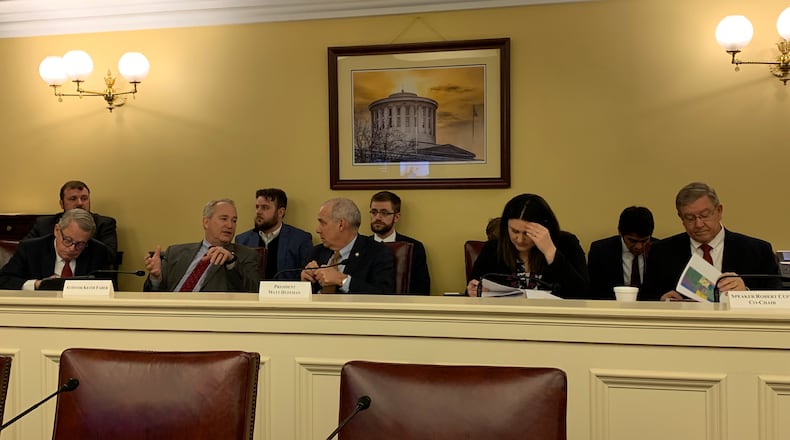Unlike during previous attempts to pass districts, the Ohio Redistricting Commission this time hired independent mapmakers, a Democrat and a Republican, to draw maps. They worked for five days under the watch of a live camera — a shift from previous attempts when maps were largely drawn behind closed doors.
But late Monday, at about 5:30 p.m., Republican members of the commission said the hired consultants were taking too long and would likely not make the court-ordered midnight deadline. Republicans then directed their staff to simultaneously create backup maps based on ones they previously passed on Feb. 24.
The Ohio Supreme Court ruled those Feb. 24 maps were unconstitutional because they did not reflect the state’s voters and unfairly favored Republicans.
The Supreme Court had ordered the commission to start from scratch.
“We’re working with a number of bad options and if one of them is we do nothing, at least this is doing something,” Huffman said earlier Monday. “We have to do something by the end of today. The Supreme Court specifically stated in their last order, there will be no extensions.”
A little after 9 p.m., the Republicans’ maps were posted on the commission website and paper copies were handed out to commission members. The maps were passed on a 4-3 vote. The two Democrats voted against the proposal, along with Republican Ohio Auditor Keith Faber. Faber had voted against the related proposal that passed on Feb. 24, citing issues with district compactness.
The latest twist in a drawn-out redistricting process drew a sharp rebuke from the two Democratic members of the Ohio Redistricting Commission and a coalition of vocal voting rights activists in the audience of the hearing room. In reaction to the vote, audience members yelled out, “shame on you,” and “cheaters.”
Republicans did not share a partisan breakdown of the maps, but described the districts as leaning 54% Republican and 46% Democratic. According to the Dave’s Redistricting App, the map is only slightly different in practice from the most recent plan rejected by the Ohio Supreme Court and likely to preserve Republican’s supermajority in the state legislature.
“Here we are again,” said commission co-chair Sen. Vernon Sykes, “doing the same thing even though the court has gone out of its way to specify how to prevent us from getting in this situation again. And you have just hijacked that whole process in trying to force feed us again with the same disrespect for the public.”
Sykes and the other Democrat on the commission advocated for giving the mapmakers more time, even asking the Supreme Court for an extension, but were overruled.
At around 11 p.m., paper copies of the final district maps drawn by the independent consultants were distributed to reporters and the commission. Democrats asked the rest of the commission to consider these maps, but Republicans rejected them.
Sykes said these maps include 45 Democratic-leaning and 54 Republican-leaning districts in the Ohio House and 15 Democratic-leaning and 18 Republican-leaning districts in the Ohio Senate.
Among other issues they raised, Republicans said the independent mapmakers’ proposal split too many cities into different districts.
Jen Miller, executive director of the Ohio League of Women Voters, a nonpartisan voting rights advocacy group, said she was disgusted and disappointed.
“(Republican commission members) failed to follow the process outlined by the court,” Miller said. “I think it’s fascinating that they’re worried about the timeline, the deadline for the court, but not the substance of the orders that have been ordered over and over again to make sure maps are not rigged for parties or candidates.”
Here are the Ohio General Assembly district maps passed by the Ohio Redistricting Commission Monday night.
Here are the maps drawn by the independent consultants:
Court involvement
In a separate process, a federal court is weighing whether to order the state to delay early voting for the May 3 primary to give more time to the redistricting process. A lawsuit from Republican activists asked the court to impose the Statehouse maps that the Ohio Supreme Court had rejected last month as unconstitutional.
Ohio Secretary of State Frank LaRose filed responses to the court’s questions Monday. The federal court will convene Wednesday to decide what happens with the primary and could be presented any maps passed Monday as maps the Supreme Court has not yet struck down.
From earlier updates:
The commission began its Tuesday work in the morning, broken up by multiple recesses. When the commission reconvened at around 4:30 p.m. on Monday, the two mapmakers said they were still revising their proposal and it would take at least a couple more hours. They provided a working map for Ohio House districts, but not a Senate map. McDonald left at 5 p.m. to catch a flight as agreed upon when he was hired, but said they were close and he trusted Johnson to finish the process.
Republicans said their longtime mapmaker Ray DiRossi would work in a separate building, since he is sick, to create another set of maps.
The commission recessed until 9 p.m., planning to restart only three hours before the deadline.
Democrats accused the Republicans of planning all along to disagree and said their staff would continue to support the hired mapmakers.
“To totally undercut (the independent mapmakers) at this point, number one is I think, again, a slap in the face to Ohio voters and completely disregarding the court order,” said Statehouse Minority Leader C. Allison Russo. “And I will tell you that we can work as long as we need to. The court would much rather us work and finish this job, than to again submit another unconstitutional map that is not drawn by the entire commission and or submit nothing.”
Russo said this curveball by Republicans is not surprising, saying the process has taken as long as it has due to Republicans’ stall and delay tactics.
The commission mapmakers Monday were still considering issues Republicans raised over the weekend and Monday morning regarding not changing incumbents’ districts too much and drawing compact districts that don’t split municipalities.
Only yesterday did the commission decide how to direct mapmakers on what to do regarding incumbents.
Miller, of the Ohio League of Women Voters, told the Dayton Daily News the commission should continue the process that they started where the public was able to watch.
“This more transparent bipartisan process created constitutional maps as a great starting point and we should continue in that direction,” Miller said. “The idea that DiRossi is holed up in the BWC building harkens back to 2011 when he was in a bunker making maps that were rigged for party outcomes rather than fairly representing Ohioans. And it’s inexcusable and unacceptable.”
Miller predicted the Republican members of the commission would draw another map that violates the constitution and pass it.
The Ohio Redistricting Commission is made up of five Republicans and two Democrats. The Republican members are Gov. Mike DeWine, Speaker of the House Bob Cupp, Senate President Matt Huffman, Auditor Keith Faber and Secretary of State Frank LaRose. The Democrats are Sen. Vernon Sykes and Statehouse Minority Leader C. Allison Russo.
If at least two Republicans and both Democrats on the commission had passed district maps, they would last 10 years. But with only Republican members voting to pass maps, they would last for four years.
About the Author





